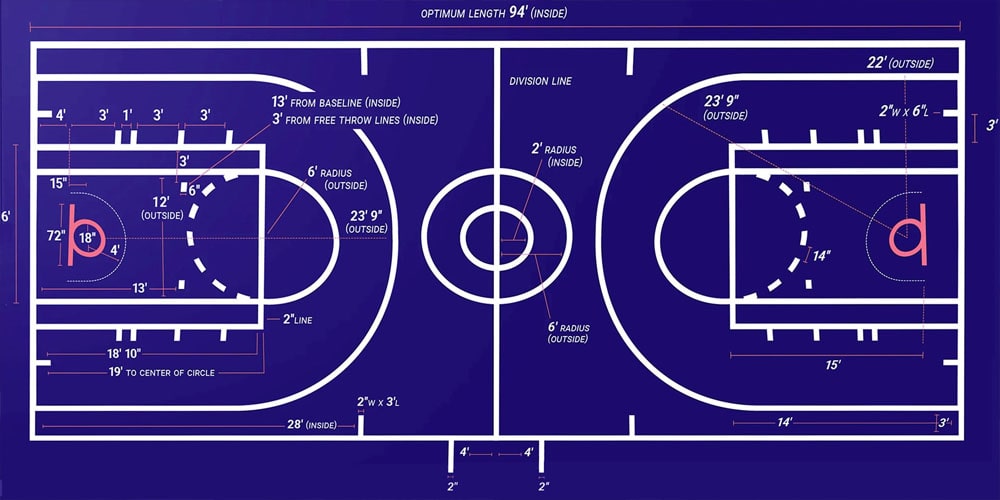Basketball is a fast-paced, dynamic sport with millions of fans around the world. Dr. James Naismith invented it in 1891. It has become one of the most popular and widely played sports globally. Like every sport, basketball rules ensure fair play. They maintain the game’s structure and improve the experience for players and fans.
Basketball is a team sport played by two teams of five players each. The main goal is to score points by shooting the ball through the opponent’s hoop. Basketball combines athleticism, strategy, and teamwork. It offers a thrilling experience for players and spectators. From NBA courts to backyard hoops, basketball is a universal game. Basketball continues to inspire and unite people of all ages and backgrounds.
Basic Basketball Rules
In basketball, the main goal is to score points while following the basketball rules. You do this by shooting the ball through the opponent’s hoop. A hoop is present at both ends of the court. The team with the most points at the end of the game wins.
Team Structure
A basketball team consists of 12 players of which only five players are allowed on the court at any given time. The positions include point guard, shooting guard, small forward, power forward, and center.
- Point Guard (PG): The primary ball handler and playmaker, responsible for setting up plays and distributing the ball.
- Shooting Guard (SG): Known for scoring, particularly through shooting from long-range and driving to the basket.
- Small Forward (SF): Versatile player who scores, rebounds, and defends, often acting as a link between guards and forwards.
- Power Forward (PF): Strong player who excels in rebounding and scoring near the basket, often playing physically in the post.
- Center (C): Usually the tallest player, focusing on rebounding, shot-blocking, and scoring close to the basket.
Positions in basketball, are purely for team strategy and do not affect the fundamental rules of the game.
Dimensions and Layout of Basketball Court
- A standard basketball court measures 94 feet long by 50 feet wide.
- Key areas include the three-point line. It is 23.75 feet from the hoop at its farthest point. There is also the key (also known as the paint), which is a rectangular box near the hoop.
- The free-throw line is positioned 15 feet from the backboard.
- The hoop is positioned 10 feet above the floor. The backboard measures 6 feet wide by 3.5 feet tall and provides a surface for rebounding and shooting.

Scoring System
- Points scored from inside the three-point line are worth 2 points.
- Points scored from beyond the three-point line are worth 3 points.
- Free throws are worth 1 point each. These are awarded in case of fouls from opponents
Game Duration
- A standard basketball game is divided into four quarters, each lasting 12 minutes.
- If the game is tied at the end of regulation time, overtime periods are played, typically lasting 5 minutes each, until a winner is determined.
Winning the Game
- To win, a team must outscore its opponent by successfully making field goals, which are worth two or three points depending on the place it was shot from.
Fouls & Violations
These fouls and violations can either be by the offensive team or the defensive team depending on the role. The list of violations is as below
- Each team can have a maximum of five players on the court. Exceeding this number results in a loss of possession, often occurring during substitutions if players do not exit the court in time.
- Traveling occurs when a player holding the ball moves one or both feet illegally. This usually happens when a player takes too many steps without dribbling or lifting their pivot foot.
- A double dribble is when a player dribbles the ball, stops, and then starts dribbling again.
- Carrying or palming occurs when a player places their hand under the ball while dribbling, which is against the rules.
- Kicking or hitting the ball with a fist is prohibited.
- Once the ball crosses the midcourt line, it cannot be brought back into the backcourt. Doing so results in a backcourt violation and turnover.
- Players must keep the ball within the court’s boundaries. Stepping out of bounds or touching the line while holding the ball is a foul. Shots taken with a foot on the line do not count.
- Violations of game conduct, such as fighting or abusive language result in a technical foul
- Defensive players cannot touch the ball while it is descending toward the basket or while it is on the rim. This interference is known as goaltending.
- Defenders must not block the inbound pass. If they do, it’s a technical foul.
Flagrant Fouls:
Involve severe, potentially injurious contact. There are two types:
- Flagrant Foul 1 (FF1): This is deemed as unnecessary contact committed by a player against an opponent. The player committing the foul is penalized but the contact is not deemed severe enough to warrant an ejection.
- Flagrant Foul 2 (FF2): This is considered both unnecessary and excessive. It involves contact that is seen as more severe. This type of foul typically results in the ejection of the player committing the foul from the game.
Then some basketball rules involving time are as follows
- Teams must attempt a shot within a set time limit (24 seconds in the NBA and WNBA, and 30 seconds in NCAA basketball). Failing to do so results in a violation termed as a Shot Clock.
- Offensive players must leave the key or paint area within three seconds. This rule is referred to as the 3-second rule.
- After a basket, the other team must inbound the ball. They must do this from a spot within five seconds. Failure to do so results in a foul.
Players can avoid giving free shots and possession to the opposition by avoiding fouls and violations. They can do this by adhering to the basketball rules.
Conclusion
Understanding the basketball rules is essential for players and fans alike. By knowing the basic rules, scoring system, and common strategies, you can enjoy the game more. You can also appreciate the skills and tactics involved. Whether you’re playing or watching, knowing basketball rules better makes the game more fun. It also helps you engage with the game more deeply.







